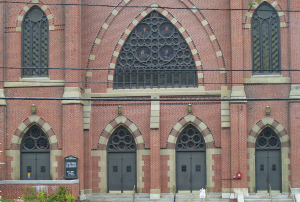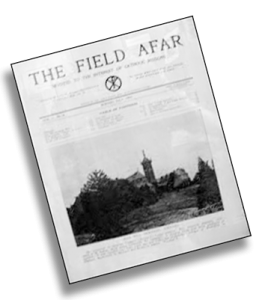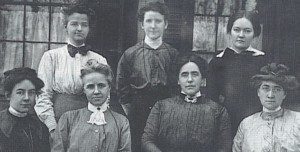Mother Mary Joseph Rogers
In 1905, a Smith College graduate named Mollie Rogers wrote to her high school newspaper: “We leave college with a sense of self-reliance and responsibility to take up our work in the world.” Little did Rogers know how far-reaching her work would be as she went on to become Mother Mary Joseph and the founder of the Maryknoll Sisters — the first order of Catholic nuns in the United States dedicated to foreign mission.
Love, tenderness, consideration and thoughtfulness for others, that is what should characterize us.
Mary Josephine Rogers, Our Foundress
Mollie’s Early Years
Mary Josephine, known as “Mollie” in her family, was born in 1882 in Boston, Massachusetts, the fourth of eight children. Her paternal grandfather, Patrick Henry, had emigrated from Ireland and was determined that his family would fit into Boston society, overcoming the prejudices to which Irish Catholics were so often subjected in the nineteenth century. To this end the Rogers children, as well as the subsequent Rogers generations, were educated in public rather than Catholic schools. At home, Mollie’s parents reinforced the faith their children learned weekly in Sunday School. They also promoted an understanding of the church’s foreign missions through the Societies for the Propagation of the Faith and the Holy Childhood.
Student Volunteer Movement at Smith College

Mollie’s early childhood acquaintance with foreign missions was little more than a distant memory when in 1901 she enrolled at Smith College in Northampton, Massachusetts. The Student Volunteer Movement at Smith was, however, very strong, and it served to reawaken Mollie’s awareness of a world beyond her own. In the spring semester of her junior year, she offered one of eight sessions of the Smith College mission study classes, probably the first ever at Smith on Catholic missions. Then, in early June, she witnessed a “mission-sending” of five of the young Protestant women who were graduating that month and would be leaving for China soon after—“the college’s best” in Mollie’s estimation. In that graced moment, she was overwhelmed with the sense of having received so much and given so little. She walked straight to her parish church just off the campus and pledged her life to the mission of the church, having no idea how she would follow through on this commitment.
After graduation, Mollie returned to Smith as a demonstrator in zoology, intending also to begin work on a master’s degree. She was unaware that the teachers then were very concerned about their Catholic students, who remained peripheral to the college’s social and religious activities. One of the teachers, Elizabeth Deering Hanscom, approached Mollie early in the semester and asked her to “do something for the Catholic girls.” Mollie’s response was to start a mission club, which evolved into what is now the Newman Club at Smith. Her search for materials led her to Father James Anthony Walsh, director of the Boston office of the Society for the Propagation of the Faith. He encouraged her, sent her materials, and at her first visit to his office, in December 1906, introduced her to his vision to inspire Catholics with regard to the church’s mission. In the United States, Catholics were one hundred years behind their Protestant peers in foreign mission endeavor. Walsh felt it was high time Catholics joined their European counterparts in spreading the Word of God. He showed her the first draft of the mission magazine he was starting, The Field Afar. Walsh was also thinking of opening a seminary to train young men as missionary priests. His vision had an electrifying effect on Mollie. Thereafter she spent summers and school breaks at his office, translating letters from French missioners for the magazine and doing various editorial tasks.

Adapting to All Situations and Cultures
In the meantime, three other women besides Mollie had come forward to offer their services to Father Walsh’s mission effort. They were Mary Louise Wholean, a graduate of Wellesley College, Wellesley, Massachusetts; Sara Sullivan, secretary to the dean at Harvard Medical School; and Mary Dwyer, a Boston businesswoman who contributed much of the machinery that was needed in publishing. In following years, women continued to come, all gathering around Mollie, the natural leader among them. Inevitably, as the women worked on The Field Afar in an atmosphere steeped in the church’s mission,they began to dream about someday being missioners themselves. It had occurred to Mollie while she was still a student at Smith that if Protestant women had a place in foreign missions, then why not also Catholic laywomen? For the women of Maryknoll, however, it was not to be that simple. Their dedicated life notwithstanding, they had no official standing as a group within the church, and therefore no stability or security. Because of their lack of official status, young women were discouraged from joining them.[8]
Mollie and the others realized that, to have a future in the mission field of the Catholic Church, they would have to establish themselves as a religious congregation. While they knew little about religious life, they knew that they wanted to be Sisters who could adapt to all kinds of situations and cultures. The Dominican Sisters of Sinsinawa, Wisconsin, who were entrusted with the final formation of the Maryknoll women, recognized the value of adaptability for missioners and purposefully fostered its development in the fledgling community.[9]
On February 14, 1920, thirty-five women welcomed the news from Archbishop Patrick Joseph Hayes of New York that they were now constituted as a bona fide religious congregation, with Mollie, now Mother Mary Joseph, as the official head of the group. From 1920 until her death, on October 9, 1955, Mother Mary Joseph spent her time and energy in the ongoing spiritual formation of the Maryknoll Sisters, who by 1955 numbered 1,160, had opened missions in twenty countries, and were serving racial minorities in six cities in the United States.
From this brief overview of Mother Mary Joseph’s life and path to Maryknoll, we turn to some aspects of the richness of her spiritual legacy.
The Presence of God
The most prominent feature of the endowment Mother Mary Joseph left to her Sisters of Maryknoll is the cultivation of the presence of God, which the Sisters identify as the taproot of her mentoring of the congregation. The presence of God, Mother Mary Joseph taught them, was the solid ground on which their relationships and all their mission activities rested.
Mother Mary Joseph often used the term “cultivate.” It was one of her signature words, and its frequent use suggests that she saw living in the presence of God as not automatic. It is not that God ever leaves us but that we are often oblivious of the Holy Mystery that enfolds us. She recognized that the Sisters would need to be active in their encounter with God’s presence, knowing that God would do the work, but not without them. She never suggested that it would be easy to balance a life of prayer with one of extreme activity.
But if the Sisters learned to cultivate God’s presence, as she told them, “Our humility will deepen, our charity towards one another will glow more warmly, our religious obligations will take on a new flavor, and we will find all things working together for good. For God is love, and where love is, there is God—there is peace.”
Mother Mary Joseph understood that, through the cultivation of God’s loving presence, the Sisters would begin to see one another as God sees them. This faith conviction inflamed her heart, and she passed it on liberally to her Sisters of Maryknoll.
Justice in Relationships
Mother Mary Joseph’s spiritual legacy also encompasses her emphasis on justice in relationships. The virtual blending of nations that now characterizes the Maryknoll Sisters congregation was only in its incipient stages during her lifetime. When she spoke about diversity in community, her predominant concern was with the differences that arose from the Sisters’ various backgrounds and individual dispositions. She knew it was hard work to live together in unity, and she also knew that it was not the Sisters’ own doing. In 1930 she told the congregation, “God is the motive power . . . the source and the object of our love. If it were not for this, do you think for one moment that we could live together in harmony and peace? We know that we could not.”
In 1932 Mother Mary Joseph told the Sisters that they were not bound by ties of natural affection. How then were they bound? “Our Charity,” she said, “is the index of our love of God and souls. What we fail to give our Sisters, we shall fail to give to thirsting souls outside.”] She rightly perceived that if the Sisters were not managing to treat one another justly and lovingly, it was very doubtful that they were accomplishing anything in mission.

The simple way in which Mollie Rogers came to accept the daunting task of founding the first American congregation of women religious for foreign mission is inspiring.With few, if any, guidelines from other people or organizations, she prayed, consulted, and constantly learned through observation and trial and error. The circumstances for mission are altogether different now, but in her day she planted seeds that enabled the Sisters to respond to the needs of their time. In order that they might thrive in community and in mission, she urged them to cultivate the presence of God. She bestowed on them the gifts of her intrepid spirit, her expansiveness of mind, and her heart, entreating them not only to love one another but indeed to see one another as God sees them.
